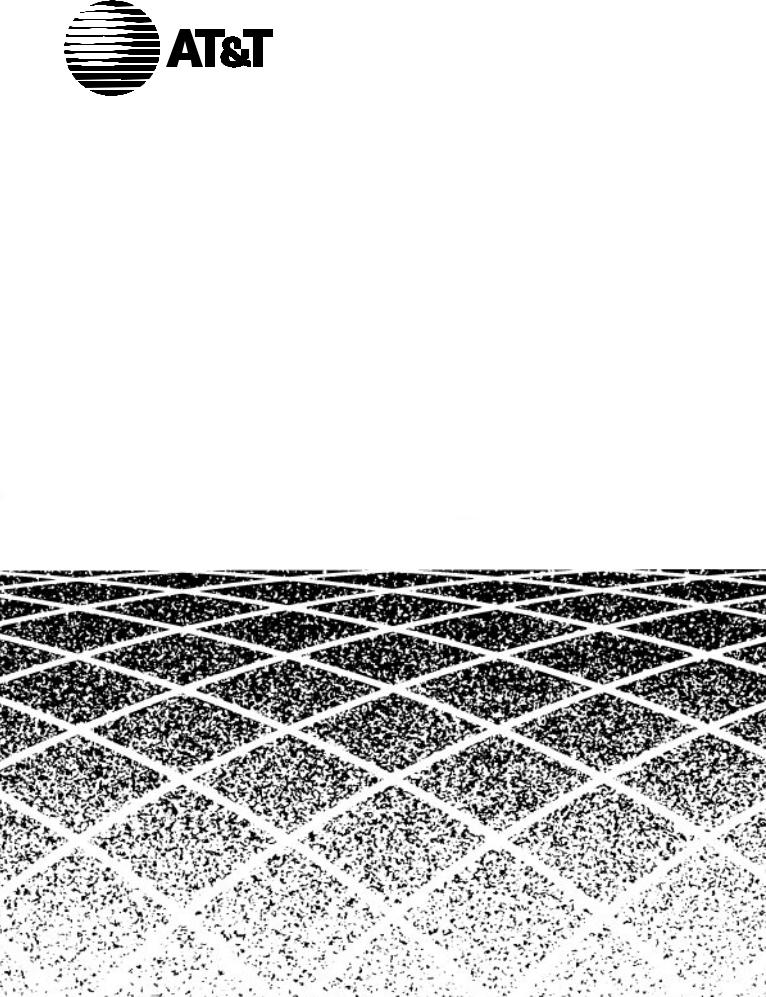AT&T G3 User Manual

585-229-107 Issue 2 April, 1996
Table of
Contents
OneVision DEFINITY G3
Proxy Agent Installation and
Connectivity
Graphics © AT&T 1988

Contents
About This Book |
xiii |
Book Overview |
xiii |
Intended Audiences |
xiv |
Typographical Conventions |
xvi |
■ Keyboard conventions |
xvii |
Your Proxy Agent Package |
xix |
Trademarks |
xxi |
Related Resources |
xxii |
Reader Comments |
xxiv |
1 |
Before You Begin |
1-1 |
|
|
|
Chapter Overview |
1-1 |
|
■ |
About the Proxy Agent |
1-2 |
|
|
Section Overview |
1-2 |
|
|
Stages of Translating PBX Data |
1-3 |
|
|
Supported PBXs |
1-4 |
|
■ |
Requirements |
1-5 |
|
|
Section Overview |
1-5 |
|
|
PC Requirements |
1-6 |
|
|
To Check Disk Space |
1-7 |
|
|
Recommended Hardware |
1-9 |
|
|
Recommended Software |
1-10 |
|
■ |
About Installations |
1-11 |
|
|
Section Overview |
1-11 |
Issue 2 April 1996 iii

Contents
UnixWare Methodology |
1-12 |
Installation and Setup Task List |
1-13 |
2 |
PC Hardware Installation |
2-1 |
|
Chapter Overview |
2-1 |
|
PC Setup Checklist |
2-2 |
3 |
UnixWare Installation |
3-1 |
|
|
|
Chapter Overview |
3-1 |
|
■ |
Installation Procedures |
3-2 |
|
|
Section Overview |
3-2 |
|
|
New Installations |
3-3 |
|
|
UnixWare 2.01 Upgrades |
3-6 |
|
|
To Set System and Node Names |
3-9 |
|
■ |
TCP/IP Administration |
3-11 |
|
|
Section Overview |
3-11 |
|
|
To Configure the Ethernet Interface |
3-12 |
|
|
To Set the Hosts File |
3-14 |
|
|
To Test the TCP/IP Connection |
3-16 |
|
|
To Troubleshoot the TCP/IP Connection |
3-17 |
iv Issue 2 April 1996

Contents
4 |
UnixWare Administration |
4-1 |
|
|
|
Chapter Overview |
4-1 |
|
■ |
Login Administration |
4-2 |
|
|
Section Overview |
4-2 |
|
|
About Logins |
4-3 |
|
|
To Add New Logins: UNIX Shell |
4-4 |
|
|
To Add New Logins: OA&M |
4-6 |
|
|
To Add New Logins: Desktop |
4-9 |
|
|
To Verify Group Assignments |
4-11 |
|
■ |
Maintenance Administration |
4-13 |
|
|
Section Overview |
4-13 |
|
|
About Port Monitors |
4-14 |
|
|
To Assign Devices to Ports |
4-15 |
|
|
To Back Up and Restore |
4-17 |
5 |
Planning Connectivity |
6-1 |
|
|
|
Chapter Overview |
6-1 |
|
■ |
About Connectivity |
6-2 |
|
|
Section Overview |
6-2 |
|
|
Proxy Agent Connectivity |
6-3 |
|
|
Communications Hardware |
6-5 |
|
■ |
Data Communications Hardware |
6-6 |
|
|
Section Overview |
6-6 |
|
|
To Choose the Hardware |
6-8 |
|
|
Proxy Agent and Modem Connections |
6-9 |
|
|
Proxy Agent and Data Module Connections |
6-10 |
Issue 2 April 1996 v

Contents
|
Proxy Agent and ADU Connections |
6-11 |
|
To Choose Circuit Packs |
6-12 |
|
PBX and Modem Connections |
6-13 |
|
PBX and Data Module Connections |
6-14 |
|
PBX and ADU Connections |
6-15 |
|
Cables for Modems |
6-16 |
|
Cables for Data Modules |
6-19 |
|
Cables for ADUs |
6-21 |
■ |
PC Hardware Connections |
6-23 |
|
Section Overview |
6-23 |
|
PC Hardware Connections |
6-24 |
|
Cables and Connectors |
6-25 |
|
To Validate Dial Strings |
6-27 |
|
To Set the Dip Switch |
6-28 |
■ |
Alarm Stream |
6-31 |
|
Section Overview |
6-31 |
|
To Connect the Modem to the PC |
6-32 |
|
Alarm Path |
6-33 |
6 |
Connectivity |
7-1 |
|
Chapter Overview |
7-1 |
|
■ Dial-Up Connections |
7-2 |
|
Section Overview |
7-2 |
|
Port Terminations |
7-3 |
|
Analog Connections |
7-4 |
|
Digital Connections |
7-7 |
vi Issue 2 April 1996

Contents
To Program PBX Ports |
7-9 |
Site-Specific Connections |
7-13 |
Multiple Connections |
7-14 |
■ Direct Connections |
7-15 |
Section Overview |
7-15 |
Requirements |
7-16 |
Procedural Overview |
7-18 |
To Install the Hardware |
7-18 |
To Configure Data Modules |
7-19 |
To Set Data Module Extensions |
7-22 |
To Update the Abbreviated Dialing List |
7-24 |
To Edit the Devices File |
7-26 |
To Set Up a Hotline Connection |
7-27 |
To Administer the Proxy Agent |
7-28 |
7 |
Serial I/O Cards |
8-1 |
|
|
|
Chapter Overview |
8-1 |
|
■ |
Installation Procedures |
8-2 |
|
|
Section Overview |
8-2 |
|
|
DigiBoard Xem |
8-3 |
|
|
Equinox SST |
8-6 |
|
|
Equinox XP |
8-7 |
|
|
Specialix XIO |
8-10 |
|
■ |
Administration Procedures |
8-11 |
|
|
Section Overview |
8-11 |
|
|
To Assign Devices to the Proxy Agent |
8-12 |
Issue 2 April 1996 vii

Contents
To Verify Device Types |
8-14 |
To Verify Dial Strings |
8-15 |
To Create Port Monitor Entries |
8-17 |
8 |
Proxy Agent Installation |
9-1 |
|
Chapter Overview |
9-1 |
|
About the Proxy Agent |
9-2 |
|
Making Preparations |
9-3 |
|
To Verify Hardware Connections |
9-4 |
|
To Verify Installed Software |
9-5 |
|
Proxy Agent Installation |
9-6 |
9 |
Proxy Agent Administration |
10-1 |
|
|
|
Chapter Overview |
10-1 |
|
■ |
Maintenance |
10-2 |
|
|
Section Overview |
10-2 |
|
|
UNIX Permissions |
10-3 |
|
|
Printers |
10-4 |
|
|
Back Up Your System |
10-5 |
|
|
Remove the Software |
10-6 |
|
■ |
Proxy Agent Configuration |
10-7 |
|
|
Section Overview |
10-7 |
|
|
To Verify the Installation |
10-8 |
viii Issue 2 April 1996

Contents
|
To Change Hardware Configuration |
10-10 |
|
To Change the User Interface |
10-13 |
■ |
Proxy Agent Connectivity |
10-17 |
|
Section Overview |
10-17 |
|
To Define External Systems |
10-18 |
|
To Connect to a PBX |
10-20 |
|
To Disconnect from a PBX |
10-22 |
■ |
Proxy Agent Customization |
10-23 |
|
Section Overview |
10-23 |
|
To Start the Proxy Agent |
10-24 |
|
The Online Guide |
10-25 |
|
To Check the Proxy Agent Status |
10-26 |
|
To Change Clients |
10-27 |
|
To Change Managers |
10-28 |
10 |
Alarms |
11-1 |
|
|
|
Chapter Overview |
11-1 |
|
■ |
Alarm Reception |
11-2 |
|
|
Section Overview |
11-2 |
|
|
Program the Alarm Receiver Port |
11-3 |
|
|
Set Modem Options for Alarm Reception |
11-9 |
|
■ |
Alarm Forwarding |
11-12 |
|
|
Section Overview |
11-12 |
|
|
Program the Alarm Sender Port |
11-13 |
|
|
Edit the Dialers File |
11-14 |
|
|
Set the Modem Options for Alarm Forwarding |
11-15 |
Issue 2 April 1996 ix

Contents
■ Program the Proxy Agent |
11-16 |
Section Overview |
11-16 |
Change Alarm Forwarding |
11-17 |
11 |
Post-Installation Tests |
12-1 |
|
Chapter Overview |
12-1 |
|
Technician Checklist |
12-2 |
|
Customer Checklist |
12-3 |
A |
PA001 Form |
A-1 |
|
Appendix Overview |
A-1 |
|
PA001 Administration Request Form |
A-2 |
B |
Design Configuration |
B-1 |
|
Appendix Overview |
B-1 |
|
■ Proxy Agent Network |
B-2 |
|
Digital Switch On-Network |
B-2 |
|
Analog On-Network |
B-4 |
|
“Other” On-Network |
B-6 |
|
Customer-Provided Multiplexor Data Networks |
B-8 |
x Issue 2 April 1996

Contents
■ Proxy Agent Connectivity |
B-11 |
Local Connection: 2000’ or Less |
|
Sys75 R1V3; G1; G3iV1, V2, V3; G3vsV1, V2, V3 |
B-12 |
Local Connection: 2000’ or Less |
|
G3rV1, V2, V3 |
B-13 |
Local Connection: 2000’ or Less |
|
Sys75 R1V3; G1; G3iV1, V2, V3; G3vsV1, V2, V3 |
B-14 |
Local Connection: 5000’ or Less |
|
G3rV1, V2, V3 |
B-15 |
Remote Connection: |
|
Sys75 R1V3; G1; G3iV1, V2, V3; G3vsV1, V2, V3 |
B-16 |
Remote Connection: |
|
G3rV1, V2, V3 |
B-17 |
C |
Basic vi |
C-1 |
|
Appendix Overview |
C-1 |
|
vi Editor |
C-2 |
D |
Proxy Agent Quick Reference |
D-1 |
|
Appendix Overview |
D-1 |
|
Hotkeys |
D-2 |
|
Commands |
D-3 |
Issue 2 April 1996 xi

Contents
GL Glossary |
GL-1 |
IN Index |
IN-1 |
xii Issue 2 April 1996

About This Book
Book Overview
In this |
This preface explains how to use this book and includes the |
||
preface |
following topics. |
|
|
|
|
|
|
|
For this information … |
See page … |
|
|
|
|
|
|
Intended Audiences |
xiv |
|
|
|
|
|
|
Typographical Conventions |
xvi |
|
|
|
|
|
|
Your Proxy Agent Package |
xix |
|
|
|
|
|
|
Trademarks |
xxi |
|
|
|
|
|
|
Related Resources |
xxii |
|
|
|
|
|
|
Reader Comments |
xxiv |
|
|
|
|
|
Issue 2 April 1996 xiii

About This Book
Intended Audiences
Intended Audiences
Introduction This book is intended for AT&T customers who use OneVisionä Network Management Solutions DEFINITYâ G3 applications to manage their PBXs on a network management system (NMS). In particular, this book is intended for:
■Network managers who use a SNMP-based network management system as a management tool
■System administrators who set up the OneVision Network Management Solutions DEFINITY G3 Proxy Agent and ensure that it performs correctly
■AT&T support personnel who are responsible for setting up and installing the Proxy Agent
What you Before you use this book to help you install the Proxy Agent, you should know should already understand how to:
■Install the required hardware
■Use UnixWareâ Release 2.01 for system administration
■Execute the UNIXâ commands necessary to move around in the directories and files
■Verify that the operating system is running and in good health
■Use one of the UNIX Editors (vi or ed) to customize Proxy Agent to meet site requirements
Earlier |
Because administration tools vary across different versions |
versions of |
of UNIX, knowledge of an earlier version of UNIX may be |
UNIX |
insufficient. |
xiv Issue 2 April 1996

About This Book
Intended Audiences
How to use This book is designed to help you get the information you need this book quickly. Most likely, you will not need to use the entire book, but will need particular information in it to meet your requirements.
Issue 2 April 1996 xv

About This Book
Typographical Conventions
Typographical
Conventions
Introduction Before you start installing the Proxy Agent, it is important to understand the typographical conventions used in this document.
Formatting The following kinds of formatting in the text identify special conventions information.
Format of text |
Type of information |
|
|
constant width |
■ Words or characters that you type. |
|
Example: Enter Proxy Agent. |
|
■ Text that displays on your screen. |
|
Example: Please remove the |
|
installation diskette and |
|
continue when ready. |
|
|
italic type |
Specialized terms. |
|
Titles of other books in the OneVision |
|
document set. |
|
|
[Bracketed text] |
Placeholders for information that you |
|
supply. |
|
Example: Enter public!g3mgt! |
|
[client string] means that you |
|
type public!g3mgt! exactly as shown, |
|
but determine the value of the client |
|
string. |
|
|
End |
In a table, signifies the end of a |
|
procedure. |
|
|
xvi Issue 2 April 1996

About This Book
Typographical Conventions
Keyboard conventions
This book uses the following keyboard conventions.
Keys |
Comments |
|
|
Key names |
All keys are shown in small type. |
|
Example: Press Enter. |
|
The keys on your keyboard may not |
|
be labeled exactly as they are in this |
|
book. |
|
|
Combination keys |
You will frequently hold down one |
|
key while you press another key. |
|
These combination keys are |
|
separated by a hyphen. |
|
Example: Press Ctrl-Y. |
|
|
Sequential keys |
You press sequential key |
|
combinations in the order shown. |
|
Example: Press Esc Esc means to |
|
press the Escape key twice. |
|
Sometimes a combination key is |
|
immediately followed by another |
|
key. |
|
Example: Press Ctrl-G G means to |
|
hold down Ctrl while pressing G, then |
|
release both keys and press G |
|
again. |
|
|
Enter and Return |
These keys generally perform the |
|
same function. This book uses Enter. |
|
If your keyboard does not have an |
|
Enter key, you can substitute the |
|
Return key. |
|
|
Issue 2 April 1996 xvii

About This Book
Typographical Conventions
Syntax |
Some conventions in syntax are: |
|
|
conventions |
|
|
|
|
|
|
|
|
Syntax |
Comments |
|
|
|
|
|
|
Enter |
The word "enter" means to type the word |
|
|
|
shown in constant width type, then press |
|
|
|
the Enter key. |
|
|
|
Example: Enter installpkg means type |
|
|
|
installpkg and then press the Enter key. |
|
|
|
|
|
|
|
|
|
Window Procedures for window-style screens use the following conventions conventions.
Format |
Comments |
à |
Shows menu selections. |
|
Example: Select Options à Print, means to |
|
select Options, then select Print from the |
|
pull-down menu. |
|
|
Bold |
Indicates buttons on the window that you |
|
click. |
|
Example: Click on Apply. |
|
|
xviii Issue 2 April 1996

About This Book
Your Proxy Agent Package
|
Your Proxy Agent |
|
|
Package |
|
What’s in |
|
|
Your Proxy Agent package includes the following resources: |
||
your |
■ This book, OneVision DEFINITY G3 Proxy Agent Installation |
|
package |
||
and Connectivity |
||
|
||
|
■ Proxy Agent software and online documents |
|
|
■ Novell's UnixWare Release 2.01 operating system software |
|
|
and documentation |
|
Online |
|
|
In addition to this book, your Proxy Agent package includes the |
||
documents |
following online documents: |
|
|
■ Command-line help provides a list of commands. |
|
|
■ Field help briefly explains the fields on a Proxy Agent form. |
|
|
■ The Proxy Agent online guide has an overview of Proxy |
|
|
Agent applications and features, tells you about menus and |
|
|
forms, and provides information about each application |
|
|
and how to use it. It also contains a table of contents, an |
|
|
index, and a glossary. |
|
How to |
|
|
You can access the online documents anytime you are using the |
||
access online |
Proxy Agent. |
documents
If you want to access |
|
this type of help … |
Then press these keys … |
|
|
Field help |
Ctrl-Y |
|
|
Online guide |
Ctrl-G G |
|
|
Issue 2 April 1996 xix

About This Book
Your Proxy Agent Package
Closing the You can exit the Proxy Agent online guide at any time by pressing online guide Ctrl-X.
xx Issue 2 April 1996

About This Book
Trademarks
Trademarks
AT&T |
■ |
DEFINITY is a registered trademark. |
trademarks |
■ |
OneVision is a trademark. |
|
Third-party All other brand and product names are the trademarks of their trademarks respective holders.
Issue 2 April 1996 xxi

About This Book
Related Resources
Related Resources
Types of |
Other documents that are related to the Proxy Agent, but not |
documents |
included with your Proxy Agent package are: |
■AT&T OneVision™ Definity Enterprise Management Project Provisioning Package
■Fault Management documents
■DEFINITY® G3 documents
Fault Man- The Fault Management documents are:
agement ■ OneVision™ Network Management Solutions DEFINITY G3 documents
Fault Management Installation and Integration
—for HP OpenView on a HP9000, 585-229-104
—for HP OpenView on a Sun Sparc OS, 585-229-105
—for Cabletron SPECTRUM on a Sun Sparc OS, 585-229-110
—for IBM NetView, 585-229-114
■OneVision™ Network Management Solutions DEFINITY G3 Fault Management Online User Guide
DEFINITY Some useful DEFINITY documents are:
documents
■ Streamlined Implementation Library
■ DEFINITY Communications System Generic 3 Feature
Description, 555-230-204
■ DEFINITY Communications System Generic 3 Capabilities,
555-230-499
xxii Issue 2 April 1996

About This Book
Related Resources
■DEFINITY Communications System Generic 1 and Generic 3 System Management, 555-230-500
■DEFINITY Communications System Generic 3r Implementation, 555-230-651
■DEFINITY Communications System Generic 3i Implementation, 555-230-650
Ordering For more information about these books and other AT&T information publications, see the Global Business Communications Systems
Publications Catalog, 555-000-010.
Third-party You may find it helpful to refer to the installation documents that documents come with your hardware and software.
Issue 2 April 1996 xxiii

About This Book
Reader Comments
Reader Comments
Comment We are interested in your suggestions for documentation card improvements and urge you to fill out the comment card and
return it to us.
Where to The reader comment card is behind the title page. find the card
If the card is If the comment card is missing, please send your comments to the missing following address:
AT&T
Product Documentation Development
Room 22-2C11
11900 North Pecos Street
Denver, Colorado 80234
Fax: (303) 538-1741
Remember to write down the document name and number on your comment sheet.
Example Proxy Agent Installation and Connectivity guide, 585-229-107.
xxiv Issue 2 April 1996

Before You Begin |
1 |
|
Chapter Overview
In this |
|
|
|
|
|
|
|
|
|
|
|
This chapter covers information you need to know before you |
|||||
chapter |
begin installing and setting up the Proxy Agent. |
||||
|
|
|
|
||
|
For this information … |
See page … |
|
||
|
|
|
|
|
|
|
About the Proxy Agent |
1-2 |
|
|
|
|
|
|
|
|
|
|
Requirements |
1-5 |
|
|
|
|
|
|
|
|
|
|
About Installations |
1-12 |
|
|
|
|
|
|
|
|
|
Issue 2 April 1996 1-1

Before You Begin
Section Overview
About the Proxy Agent
Section Overview
In this |
This section contains the following information. |
|
section |
|
|
|
|
|
|
For this information … |
See page … |
|
|
|
|
Stages of Translating PBX Data |
1-3 |
|
|
|
|
Supported PBXs |
1-4 |
|
|
|
1-2 Issue 2 April 1996

Before You Begin
Stages of Translating PBX Data
Stages of Translating
PBX Data
Description The Proxy Agent translates data from a DEFINITY G3 PBX into a format that your network management system can understand.
Process |
The following table shows the process for translating PBX data. |
|
||
|
|
|
|
|
|
Step |
What does it |
Description |
|
|
|
|
|
|
|
1 |
DEFINITY G3 |
Sends PBX management data to the |
|
|
|
PBX |
Proxy Agent. |
|
|
|
|
|
|
|
2 |
Proxy Agent |
Translates the data from the |
|
|
|
|
DEFINITY OSSI (Operating Support |
|
|
|
|
System Interface) and alarm format |
|
|
|
|
to the SNMP (Simple Network |
|
|
|
|
Management Protocol) format. |
|
|
|
|
|
|
|
3 |
Proxy Agent |
Forwards the PBX management data |
|
|
|
|
to the network management system. |
|
Other |
|
|
|
|
|
|
|||
The Proxy Agent also provides administrative access to the switch |
|
|||
functions |
to accommodate those functions not provided by SNMP. |
|
||
Issue 2 April 1996 1-3

Before You Begin
Supported PBXs
Supported PBXs
Types of |
The Proxy Agent supports the following DEFINITY G3 PBXs. |
|||
PBXs |
|
|
|
|
|
|
|
|
|
|
G3vs |
G3s |
G3i |
G3r |
|
|
|
|
|
|
V1.1 - ABP/PBP |
V1.1 - ABP/PBP |
V1.1 - 286 |
V1.1 |
|
|
|
|
|
|
V2 - ABP/PBP |
V2 - ABP/PBP |
V2 - 386 |
V2 |
|
|
|
V2 - 286 |
|
|
|
|
|
|
|
V3 - ABP/PBP |
V3 - ABP/PBP |
V3 - 386 |
V3 |
|
|
|
|
|
|
V4 - ABP/PBP |
V4 - ABP/PBP |
V4 - 386 |
V4 |
|
|
|
|
|
1-4 Issue 2 April 1996

Before You Begin
Section Overview
Requirements
Section Overview
In this |
This section contains the following information. |
|
section |
|
|
|
|
|
|
For this information … |
See page … |
|
|
|
|
PC Requirements |
1-6 |
|
|
|
|
To Check Disk Space |
1-7 |
|
|
|
|
Recommended Hardware |
1-10 |
|
|
|
|
Recommended Software |
1-11 |
|
|
|
Issue 2 April 1996 1-5

Before You Begin
PC Requirements
PC Requirements
Type of PC The Proxy Agent requires an industry standard Intel 486 (or later) processor-based personal computer with ISA BUS slots.
Required For the Proxy Agent to run properly, your PC must have:
configura-
■ A 3.5-inch, 1.44-MB diskette drive
tion
■16 MB of random access memory
■A hard disk of at least 500 MB
■A CD-ROM drive, 2x or greater
■A Serial I/O ports board
■UnixWare Release 2.01 compatible, 10 Mbit network interface card
See Recommended Hardware on page 1-10 for more information.
Required Estimates of the disk space that the Proxy Agent requires during disk space installation are in the following table. Disk space on UnixWare is in
512-byte blocks.
Directory Blocks
/tmp 2,000
/usr 2,000
Total 4,000
Remember, space requirements expand as you generate data files.
1-6 Issue 2 April 1996

Before You Begin
To Check Disk Space
To Check Disk Space
When to use Check the amount of unused disk space before you install the Proxy Agent to ensure that there is enough room.
Types of |
The install script for the Proxy Agent uses the following directories. |
directories |
|
Issue 2 April 1996 1-7
